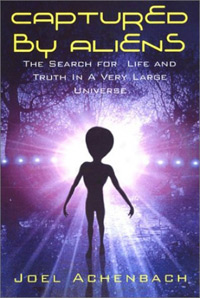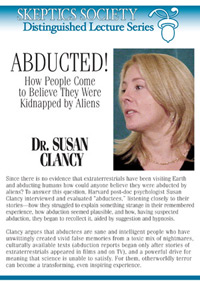In this week’s eSkeptic:
Dr. Daphne J. Fairbairn, on Demand
Odd Couples: Extraordinary Differences Between the Sexes in the Animal Kingdom
While we joke that men are from Mars and women are from Venus, our gender differences can’t compare to those of other animals. For instance: the male garden spider spontaneously dies after mating with a female more than 50 times his size. Female cichlids must guard their eggs and larvae—even from the hungry appetites of their own partners. And male blanket octopuses employ a copulatory arm longer than their own bodies to mate with females that outweigh them by four orders of magnitude. Why do these gender gulfs exist? This lecture, based on her book, explores some of the most extraordinary sexual differences in the animal world. From the fields of Spain to the deep oceans, evolutionary biologist Daphne Fairbairn uncovers the unique and bizarre characteristics that exist in these remarkable species and the special strategies they use to maximize reproductive success. Fairbairn also considers humans and explains that although we are keenly aware of our own sexual differences, they are unexceptional within the vast animal world.
Rent this video for only $3.95 or
Watch the entire series for $49.
INSTRUCTIONS: Click the button above, then click the RENT ONE button on the page that will open in your Internet browser. You will then be asked to login to your Vimeo account (or create a free account). Once you complete your purchase of the video rental, you will then be able to instantly stream the video to your computer, smartphone, or tablet, and watch it for the rental period. Videos play best on Vimeo when you allow the entire video to buffer before viewing it.


MonsterTalk # 85
Alienable Rites
What causes a person to be possessed? Are there demons? Is it mental illness? Is it abnormal neurology? Does exorcism work? in this episode of MonsterTalk, paranormal researcher psychologist Dr. Chris French joins us to discuss the psychology of demonic possession and exorcisms.
About this week’s eSkeptic
In this week’s eSkeptic, Michael Shermer recounts the time he was abducted by aliens. This is a review of Captured by Aliens: The Search for Life and Truth in a Very Large Universe, by Joel Achenbach. This review appeared in Skeptic magazine 7.4 (1999)
Share this article with friends online.
Subscribe | Donate | Watch Lectures | Shop
ET Phone Me
by Michael Shermer
In the wee hours of the morning of August 8, 1983, I was abducted by aliens. I was traveling down a lonely rural highway just west of Haigler, NB, when a large craft with bright lights appeared and, despite my best efforts to resist, forced me into their vehicle. After regaining consciousness 90 minutes later, I was back on the road but with no memory of what transpired inside. These aliens, however, were not the stereotypical “grays” with bulbous heads and almond-shaped eyes. These looked just like humans, but I knew they were aliens because they had stiff little fingers.
Joel Achenbach would love this story because it fits the theme of his splendid new book so well—a fantastic yarn with a prosaic explanation that tells us far more about humans than aliens. In my case I had ridden a bicycle over 1250 miles nonstop from Santa Monica, CA, as part of the 3,000-mile nonstop transcontinental bicycle Race Across America, stretching my ad hoc sleep deprivation experiment to 83 hours. The alien craft? My brightly lit motorhome. The aliens? My support crew. The lost 90 minutes? A sleep break. The stiff little fingers? The memory of a 60’s TV series, The Invaders, in which aliens shapeshifted into human forms but, for some peculiar reason, could not bend their pinkies.
What Achenbach would like about this story is what it tells us about how culture determines the content of our apparitions. The demon-haunted world of the Middle Ages was filled with tales of people abducted by incubi and succubi; in the spirit-haunted world of 19th-century England and America people were harassed by ghosts and apparitions. We no longer experience demons and spirits because, Achenbach says in a clever title double-entendre, our culture has been captured by aliens. From Star Trek and Star Wars to ET and XFiles on the pop culture front, and from NASA’s Search for ExtraTerrestrial Intelligence (SETI) program to the Mars’ rock microbes on the scientific front, Achenbach shows just how powerful this theme is in our collective imagination. We live in an alien-haunted world.
Yet evidence for alien existence is, well, nonexistent, and this is where Achenbach’s narrative gets interesting. Humans are, by nature, pattern-seeking, storytelling animals, and we are quite adept at creating patterns whether they exist or not. Aliens are the Rorshach of our age, an ET inkblot of our unconscious hopes and fears, where superior intelligences with wisdom far beyond our comprehension have made, are making, or will make contact with Earth, and from these contacts we have, are, or will glean the knowledge we need to save ourselves and our planet. As Achenbach takes us on his “travelogue” through our alien-haunted world, we encounter everything from the sublime (the leaders of NASA, SETI, the Planetary Society and the Mars Society) to the ridiculous (the followers of the Aetherius Society, the Unarius Academy of Science, and Heaven’s Gate).
This is science writing at its best—I could not put the book down and read it on planes, taxis, and even during interview breaks on a book tour—and it should be required reading for all scientists who want to explain what it is they do. After years of “doodling around in alien country,” for example, Achenbach thinks the UFO phenomenon “can be viewed as an astrosociopolitical issue of great complexity, or, more simply, as a question of human psychology. Why do some people construct their world-views around ideas that other people find ludicrous? Where’s the fault line? It’s not intelligence or social class. It’s not like poor, fat, Velveeta-eating people believe in aliens and rich, thin, brie-eating people don’t.” (He does, however, identify my neck of the woods as alien central: “Aliens seem to be more prevalent in the West, and in California they’re simply taken for granted, more strange guests at the cocktail party.”)
And when Achenbach meets with alien true believers, such as Roswell afficionado Philip Corso, he confronts an uncomfortable choice: “Either he saw an alien corpse, and later became engaged in a massive program to reverse-engineer UFO technology, which in turn helped win the Cold War and stave off the full-bore alien invasion—or his tale is a lie. There’s not much middle ground there. How do you decide? Lacking direct information, one must go on feel and smell and instinct. You have to ask yourself if there might be a narcissistic impulse behind his book. You have to linger a moment on the wonderful penultimate sentence: ‘Sometimes, once in a very long while, you get the chance to save your country, your planet, and even your species at the same time.’ (And write a best-seller.)” That’s good prose.
Achenbach is a journalist, not a social scientist (thus accounting for his inability to construct obfuscating paragraph-long sentences sprinkled with “therefores,” “furthermores,” and “moreovers”), so don’t look for hypothesis testing of the latest social psychological theory of mass hysteria or cognitive dissonance. His insights into human nature instead come from a more basic and in many ways deeper understanding through real world experiences with the participants themselves (outsiders would be amazed to learn just how many psychological theories were constructed around the thoughts and behaviors of students cajoled into participating in their professors’ experiments). At the core of this secular religion, as with its theistic counterparts, is faith, the ultimate prophylactic against skeptics. When I read the following passage, in fact, I was jolted back in my seat:
The UFO movement’s strength is not in its evidence but in its overall narrative, its theme. It has an elaborate eschatology, a host of apostles, and a recurring theme of doom versus salvation. It is not the evidence of extraterrestrial creatures but, rather the idea of the Alien that makes ufology such a powerful faith. The skeptics can dismiss the purported tales of aliens and show the logical flaws in the story, but it will never make any difference. If an idea is sufficiently wonderful, if it springs from deep yearnings, it can easily beat back the yappings of logicans and skeptics and disbelieving journalists.
So are Achenbach and myself (a disbelieving journalist and skeptic respectively) wasting our time tilting at alien windmills? What should we do when we confront that fault line between fantasy and reality? What Would Carl Do?, we might ask, paraphrasing the popular catch phrase of another faith. If, as Achenbach says, Sagan was “the gatekeeper of any serious discussion of extraterrestrial life,” the “go-to guy for anyone with a new idea,” and the man who decided “if a creative idea should be allowed into the lecture hall or instead left outside,” then what would Carl do when facing the veracity question? “Someone has to propose ideas at the boundaries of the plausible,” Sagan once said, “in order to so annoy the experimentalists or observationalists that they’ll be motivated to disprove the idea.” Yet Carl was also fond of quoting the skeptics’ mantra “Extraordinary claims demand extraordinary evidence.”
Enough of the blurry photographs, grainy videos, and anecdotes about things that go bump in the night. Until ET phones me I will have to settle for being amazed and amused by the tales of alien dreamers so well recounted in this beautifully written book. ![]()
Carbon Dating: A Comic Strip About Science, Pseudoscience, and Geeky Relationships
We all have irrational, ridiculous, and nonsensical ideas that we cling to. Maybe you’re deathly afraid of spiders, or GMOs, or gluten? That’s OK! If you aren’t, your friends probably are, and their Facebook posts will not let you forget it. That’s the driving theme behind Carbon Dating. If you can get people to laugh at their favorite pseudoscience, maybe they won’t take it so seriously.
Carbon Dating is a bi-weekly comic strip published free online and also in Skeptic magazine quarterly (as Carbon Comic).
Online currently, new comics are posted every Tuesday and Friday — but, with your support via KickStarter, it can become a daily comic strip! To learn more and to help support this project, see the KickStarter page for more details.















